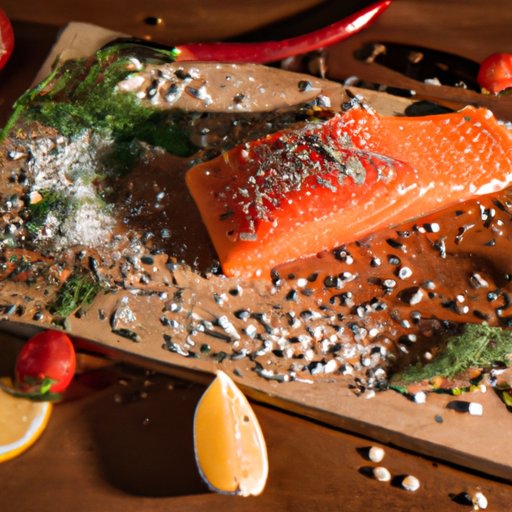
How to Know Salmon Is Done: Exploring Different Methods
Cooking salmon is easy, but knowing when it is done can be tricky. Several variables, such as the thickness of the fish, cooking method, and personal preferences, can affect the cooking time and temperature of salmon. Overcooked salmon can ruin the taste and texture of the fish, while undercooked salmon can be dangerous and even cause food poisoning. Therefore, it’s essential to know how to tell when salmon is cooked to perfection. In this article, we will discuss several ways to know when salmon is done and provide some tips for cooking salmon perfectly every time.
Use a Meat Thermometer
A meat thermometer is a reliable tool for measuring the internal temperature of salmon accurately. Insert the thermometer into the thickest part of the fish, making sure not to touch the bone. The optimal temperature to cook salmon is 145°F (63°C). Once the salmon reaches this temperature, remove it from the heat source immediately. Overcooking the salmon can result in dry and tough meat.
Some chefs recommend cooking salmon to a slightly lower temperature of 135°F (57°C) to preserve the moistness of the fish. However, if you’re cooking salmon for an immune-compromised person, pregnant woman, or young children, it’s best to cook it to the FDA recommended temperature of 145°F to avoid the risk of bacteria and parasites that can be present in undercooked fish.
When using a meat thermometer, make sure to calibrate it before each use to ensure accurate readings. Rinse the thermometer with hot water, insert it into a pot of boiling water, and it should register 212°F (100°C). If it doesn’t, adjust it accordingly.
Observe the Color
Another way to know when salmon is done is to observe the color of its flesh. Fully cooked salmon should have a bright coral color and be opaque throughout its thickness. As salmon cooks, its color changes from translucent to pink and then to opaque. The pink color should be vivid and even throughout the flesh.
However, different salmon species have different flesh colors, and salmon farmed in different regions may be dyed or have a different color than wild salmon. Therefore, it’s not always reliable to rely solely on color to determine if the salmon is cooked to perfection.
Check for Flakiness
Cooked salmon should easily flake apart with a fork. To check if the salmon is done, gently press down on it with a fork, and see if it flakes. The cooked flesh should come off in large, tender, and moist flakes. If the flakes are small, dry, and fall apart quickly, the salmon may be overcooked or undercooked.
Time It
Time is another essential factor in cooking salmon to perfection. The cooking time can vary depending on the thickness of the salmon and the cooking method. As a general rule of thumb, cook salmon for 10 minutes per inch of thickness. For example, a 1-inch-thick piece of salmon should take about 10 minutes to cook. For fillets or steaks that are less than 1/2 inch thick, reduce the cooking time to six minutes or less.
If you’re cooking salmon in the oven, preheat the oven to 400°F (200°C) and bake the salmon for 12-15 minutes, depending on the thickness. If you’re grilling the salmon, preheat the grill to medium-high heat, and cook for 3-4 minutes per side.
The best way to be sure that the salmon is cooked to perfection is to set a timer and check it periodically until it reaches the desired doneness. Take the salmon off the heat source as soon as it reaches 145°F internal temperature or when the flesh flakes apart easily.
Apply Pressure
Cooked salmon should be firm to the touch but still have some ‘give.’ To test if the salmon has reached this level of firmness, gently press down on the top of the salmon with your finger or a fork. If the salmon is firm and bounces back when you release the pressure, it’s cooked. If it’s still soft and mushy, it needs to cook a bit longer.
Look for White Substance
Fully cooked salmon will release a white protein substance called albumin. While this may sound unappetizing, it’s a good sign that the salmon is done. Check the surface of the salmon for white specks or a white foam-like substance. If you see any, it’s time to take the salmon off the heat source.
Trust Your Senses
While there are several ways to know when salmon is done, there’s no definitive answer. The best way to tell if salmon is cooked to perfection is to trust your senses and develop an intuition. With practice, you’ll learn to recognize the signs that indicate the salmon is done just the way you like it.
Here are some general tips for cooking salmon to perfection:
- Cook salmon at a moderate temperature to avoid overcooking or undercooking.
- Season the salmon with salt, pepper, and other herbs or spices to enhance its flavor.
- Use a non-stick pan or coat the pan with cooking spray to prevent the salmon from sticking.
- Don’t overcrowd the salmon in the pan or on the grill to ensure even cooking.
- Let the salmon rest for a few minutes after cooking to allow the flavors to develop and the juices to redistribute.
Conclusion
The best way to know when salmon is done is to use a combination of the methods outlined above. Whether you’re using a meat thermometer, observing the color, checking for flakiness, timing it, applying pressure, looking for white substance, or trusting your senses, make sure to take the salmon off the heat source as soon as it’s done to avoid overcooking it. Cooking salmon to perfection takes practice, but with these tips, you’ll be able to cook salmon to perfection every time.




